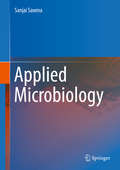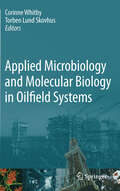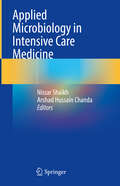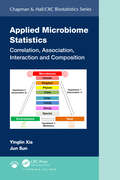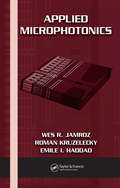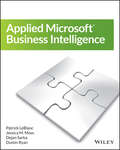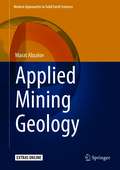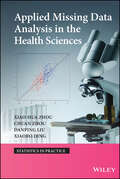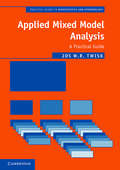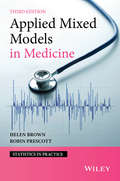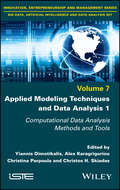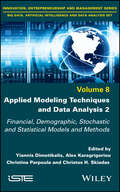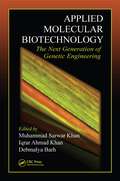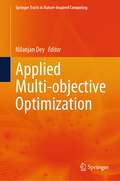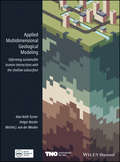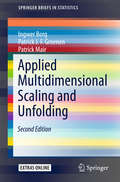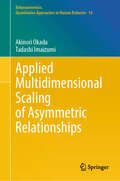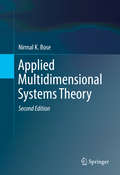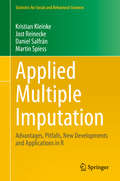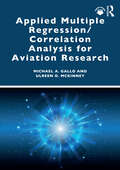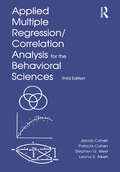- Table View
- List View
Applied Microbiology
by Sanjai SaxenaThe book is oriented towards undergraduates science and engineering students; postgraduates and researchers pursuing the field of microbiology, biotechnology, chemical - biochemical engineering and pharmacy. Various applications of microorganisms have been covered broadly and have been appropriately reflected in depth in 12 different chapters. The book begins with an insight to the diverse niche of microorganisms which have been explored and exploited in development of various biotechnological products and green processes. Further, how these microorganisms have been genetically modified to improve the desired traits for achieving optimal production of microbially derived products is discussed in the second chapter. Major route of production of microbially derived products and processes is through fermentation technology and therefore due emphasis on different aspects of fermentation technology has been given in the subsequent chapter. The development and deployment of biopesticides and biofertilizers which find tremendous application have been separately discussed under agricultural applications. Application of microbes for the removal of pollutants, recovery of metals and oils has also been discussed under environmental applications. The role of microbial systems in development of fermented foods and beverages have also been discussed in Chapter 6. The application of microbes in production of commodity chemicals and fine chemicals has also been discussed in separate chapters. A chapter has been dedicated to the tremendous applications of microbially produced enzymes in different industrial sectors. Another unique facet of this book is explaining the different methods by which desired traits of microorganisms have been improved for their efficacious and economical exploitation in the industry. A chapter is dedicated to exploitation of microorganisms in development of vaccines for human and veterinary use. Finally, the last chapter discusses the role of immobilization in optimization of industrial processes and development of microbial biosensors for industrial applications. Thus, this book is a holistic approach providing information on the present applications of microorganisms.
Applied Microbiology and Molecular Biology in Oilfield Systems: Proceedings from the International Symposium on Applied Microbiology and Molecular Biology in Oil Systems (ISMOS-2), 2009
by Torben Lund Skovhus Corinne WhitbyApplied Microbiology and Molecular Biology in Oil Field Systems addresses the major problems microbes cause in oil fields, (e.g. biocorrosion and souring) and how beneficial microbial activities may be exploited (e.g. MEOR and biofuels). The book describes theoretical and practical approaches to specific Molecular Microbiological Methods (MMM), and is written by leading authorities in the field from both academia and industry. The book describes how MMM can be applied to faciliate better management of oil reservoirs and downstream processes. The book is innovative in that it utilises real industrial case studies which gives useful technical and scientific information to researchers, engineers and microbiologists working with oil, gas and petroleum systems.
Applied Microbiology in Intensive Care Medicine
by Nissar Shaikh Arshad Hussain ChandaThis book covers microbiological features of the diseases that require intensive care support, including iatrogenic and hospital-acquired infections. The knowledge will assist in the early diagnosis and treatment of bacterial, viral, and fungal infections requiring critical care admission to improve patient outcomes. All microbiological and therapeutic concerns and management of infectious disorders of all human body systems, from the brain to the musculoskeletal system, are addressed. It also describes practical and descriptive ways to prevent, diagnose, and manage various known and forthcoming healthcare-associated illnesses, ranging from MRSA to VRE and others. Applied Microbiology in Intensive Care Medicine will benefit not only intensive and critical care practitioners but also infectious disease practitioners and physicians, surgeons, intensivists, clinical pharmacists, nurses, and technicians in intensive care units.
Applied Microbiome Statistics: Correlation, Association, Interaction and Composition (Chapman & Hall/CRC Biostatistics Series)
by Jun Sun Yinglin XiaThis unique book officially defines microbiome statistics as a specific new field of statistics and addresses the statistical analysis of correlation, association, interaction, and composition in microbiome research. It also defines the study of the microbiome as a hypothesis-driven experimental science and describes two microbiome research themes and six unique characteristics of microbiome data, as well as investigating challenges for statistical analysis of microbiome data using the standard statistical methods. This book is useful for researchers of biostatistics, ecology, and data analysts. Presents a thorough overview of statistical methods in microbiome statistics of parametric and nonparametric correlation, association, interaction, and composition adopted from classical statistics and ecology and specifically designed for microbiome research. Performs step-by-step statistical analysis of correlation, association, interaction, and composition in microbiome data. Discusses the issues of statistical analysis of microbiome data: high dimensionality, compositionality, sparsity, overdispersion, zero-inflation, and heterogeneity. Investigates statistical methods on multiple comparisons and multiple hypothesis testing and applications to microbiome data. Introduces a series of exploratory tools to visualize composition and correlation of microbial taxa by barplot, heatmap, and correlation plot. Employs the Kruskal–Wallis rank-sum test to perform model selection for further multi-omics data integration. Offers R code and the datasets from the authors’ real microbiome research and publicly available data for the analysis used. Remarks on the advantages and disadvantages of each of the methods used.
Applied Microphotonics (Optical Science and Engineering)
by Wes R. Jamroz Roman Kruzelecky Emile I. HaddadAs the limits of electrical performance come within sight, photons are poised to take over for the electron. But the search continues for the materials, topologies, and fabrication technologies capable of producing photonic devices at a reasonable speed and cost. Taking a fundamentallook at the development of photonic technology from the macro- to the microscale, Applied Microphotonics introduces the major principles and technologies underlying the field.Following an overview of historical and commercial driving forces, the authors briefly review the underlying physics, emphasizing the practical and design implications for photonic systems. This general discussion lays the foundation for the remainder of the book, where the authors first introduce the photonic node and then discuss each subsystem in detail, including transmitters, couplers and switches, multiplexers and demultiplexers, receivers, amplifiers, and compensators. The following chapters explore new technologies such as photonic band gap structures, materials and fabrication processes, integration methodologies, and advanced devices such as photonic computers. The book concludes with a brief introduction to quantum photonics and a forward look at potential directions of photonics. Applied Microphotonics encapsulates the recent push toward all-optical networks and devices with an applications-oriented perspective. It is ideal for newcomers to the field as well as anyone curious to know how photonic technology can benefit their own field.
Applied Microsoft Business Intelligence
by Dejan Sarka Patrick Leblanc Jessica M. Moss Dustin Ryanffective enterprise solutionsSearch, analyze, and visualize data more efficiently and completelyDevelop flexible and scalable tabular and multidimensional modelsMonitor performance, build a BI portal, and deploy and manage the BI Solution
Applied Microsoft® Windows® .NET Framework Programming
by Jeffrey Richter<div xmlns="http://www.w3.org/1999/xhtml"><p>Find out all about the .NET Framework common language runtime and learn how to leverage its power to build, package, and deploy any kind of application or component with this book\u2014ideal for anyone who understands object-oriented programming concepts.</p></div>
Applied Minds: How Engineers Think
by Guru MadhavanA journey inside the minds that build our world. Dubai's Burj Khalifa--the world's tallest building--looks nothing like Microsoft's Office Suite, and digital surround sound doesn't work like a citywide telecommunication grid. Yet these engineering feats have much in common. Applied Minds explores the unique visions and mental tools of engineers to reveal the enormous--and often understated--influence they wield in transforming problems into opportunities. The resulting account pairs the innovators of modern history--Thomas Edison, the Wright brothers, Steve Jobs--with everything from ATMs and the ZIP code system to the disposable diaper. An engineer himself, Guru Madhavan introduces a flexible intellectual tool kit called modular systems thinking as he explains the discipline's penchant for seeing structure where there is none. The creations that result from this process express the engineer's answers to the fundamental questions of design: usefulness, functionality, reliability, and user friendliness. Through narratives and case studies spanning the brilliant history of engineering, Madhavan shows how the concepts of prototyping, efficiency, reliability, standards, optimization, and feedback are put to use in fields as diverse as transportation, retail, health care, and entertainment. Equal parts personal, practical, and profound, Applied Minds charts a path to a future where we apply strategies borrowed from engineering to create useful and inspired solutions to our most pressing challenges.
Applied Mineral Inventory Estimation
by Alastair J. Sinclair Garston H. BlackwellApplied Mineral Inventory Estimation presents a comprehensive applied approach to the estimation of mineral resources/reserves with particular emphasis on the geological basis of such estimations, the need for and maintenance of a high quality assay data base, the practical use of a comprehensive exploratory data evaluation, and the importance of a comprehensive geostatistical approach to the estimation methodology. Practical problems and real data are used throughout as illustrations: each chapter ends with a summary of practical concerns, a number of practical exercises and a short list of references for supplementary study. This textbook is suitable for any university or mining school that offers senior undergraduate and graduate student courses on mineral resource/reserve estimation. It will also be valuable for professional mining engineers, geological engineers and geologists working with mineral exploration and mining companies.
Applied Mining Geology (Modern Approaches in Solid Earth Sciences #12)
by Marat AbzalovThis book provides a detailed overview of the operational principles of modern mining geology, which are presented as a good mix of theory and practice, allowing use by a broad range of specialists, from students to lecturers and experienced geologists.The book includes comprehensive descriptions of mining geology techniques, including conventional methods and new approaches. The attributes presented in the book can be used as a reference and as a guide by mining industry specialists developing mining projects and for optimizing mining geology procedures. Applications of the methods are explained using case studies and are facilitated by the computer scripts added to the book as Electronic Supplementary Material.
Applied Missing Data Analysis in the Health Sciences
by Xaiobo Ding Danping Lui Xiao-Hua Zhou Chuan ZhouA modern and practical guide to the essential concepts and ideas for analyzing data with missing observations in the field of biostatisticsWith an emphasis on hands-on applications, Applied Missing Data Analysis in the Health Sciences outlines the various modern statistical methods for the analysis of missing data. The authors acknowledge the limitations of established techniques and provide newly-developed methods with concrete applications in areas such as causal inference methods and the field of diagnostic medicine.Organized by types of data, chapter coverage begins with an overall introduction to the existence and limitations of missing data and continues into traditional techniques for missing data inference, including likelihood-based, weighted GEE, multiple imputation, and Bayesian methods. The book's subsequently covers cross-sectional, longitudinal, hierarchical, survival data. In addition, Applied Missing Data Analysis in the Health Sciences features:Multiple data sets that can be replicated using the SAS®, Stata®, R, and WinBUGS software packagesNumerous examples of case studies in the field of biostatistics to illustrate real-world scenarios and demonstrate applications of discussed methodologiesDetailed appendices to guide readers through the use of the presented data in various software environmentsApplied Missing Data Analysis in the Health Sciences is an excellent textbook for upper-undergraduate and graduate-level biostatistics courses as well as an ideal resource for health science researchers and applied statisticians.
Applied Mixed Model Analysis: A Practical Guide (Practical Guides to Biostatistics and Epidemiology)
by Jos W. TwiskThis practical book is designed for applied researchers who want to use mixed models with their data. It discusses the basic principles of mixed model analysis, including two-level and three-level structures, and covers continuous outcome variables, dichotomous outcome variables, and categorical and survival outcome variables. Emphasizing interpretation of results, the book develops the most important applications of mixed models, such as the study of group differences, longitudinal data analysis, multivariate mixed model analysis, IPD meta-analysis, and mixed model predictions. All examples are analyzed with STATA, and an extensive overview and comparison of alternative software packages is provided. All datasets used in the book are available for download, so readers can re-analyze the examples to gain a strong understanding of the methods. Although most examples are taken from epidemiological and clinical studies, this book is also highly recommended for researchers working in other fields.
Applied Mixed Models in Medicine (Statistics in Practice #28)
by Helen Brown Robin PrescottA fully updated edition of this key text on mixed models, focusing on applications in medical research The application of mixed models is an increasingly popular way of analysing medical data, particularly in the pharmaceutical industry. A mixed model allows the incorporation of both fixed and random variables within a statistical analysis, enabling efficient inferences and more information to be gained from the data. There have been many recent advances in mixed modelling, particularly regarding the software and applications. This third edition of Brown and Prescott’s groundbreaking text provides an update on the latest developments, and includes guidance on the use of current SAS techniques across a wide range of applications. Presents an overview of the theory and applications of mixed models in medical research, including the latest developments and new sections on incomplete block designs and the analysis of bilateral data. Easily accessible to practitioners in any area where mixed models are used, including medical statisticians and economists. Includes numerous examples using real data from medical and health research, and epidemiology, illustrated with SAS code and output. Features the new version of SAS, including new graphics for model diagnostics and the procedure PROC MCMC. Supported by a website featuring computer code, data sets, and further material. This third edition will appeal to applied statisticians working in medical research and the pharmaceutical industry, as well as teachers and students of statistics courses in mixed models. The book will also be of great value to a broad range of scientists, particularly those working in the medical and pharmaceutical areas.
Applied Modeling Techniques and Data Analysis 1: Computational Data Analysis Methods and Tools
by Alex Karagrigoriou Yannis Dimotikalis Christina Parpoula Christos H SkiadasBIG DATA, ARTIFICIAL INTELLIGENCE AND DATA ANALYSIS SET Coordinated by Jacques Janssen Data analysis is a scientific field that continues to grow enormously, most notably over the last few decades, following rapid growth within the tech industry, as well as the wide applicability of computational techniques alongside new advances in analytic tools. Modeling enables data analysts to identify relationships, make predictions, and to understand, interpret and visualize the extracted information more strategically. This book includes the most recent advances on this topic, meeting increasing demand from wide circles of the scientific community. Applied Modeling Techniques and Data Analysis 1 is a collective work by a number of leading scientists, analysts, engineers, mathematicians and statisticians, working on the front end of data analysis and modeling applications. The chapters cover a cross section of current concerns and research interests in the above scientific areas. The collected material is divided into appropriate sections to provide the reader with both theoretical and applied information on data analysis methods, models and techniques, along with appropriate applications.
Applied Modeling Techniques and Data Analysis 2: Financial, Demographic, Stochastic and Statistical Models and Methods
by Alex Karagrigoriou Christos H. Skiadas Yannis Dimotikalis Christina ParpoulaBIG DATA, ARTIFICIAL INTELLIGENCE AND DATA ANALYSIS SET Coordinated by Jacques Janssen Data analysis is a scientific field that continues to grow enormously, most notably over the last few decades, following rapid growth within the tech industry, as well as the wide applicability of computational techniques alongside new advances in analytic tools. Modeling enables data analysts to identify relationships, make predictions, and to understand, interpret and visualize the extracted information more strategically. This book includes the most recent advances on this topic, meeting increasing demand from wide circles of the scientific community. Applied Modeling Techniques and Data Analysis 2 is a collective work by a number of leading scientists, analysts, engineers, mathematicians and statisticians, working on the front end of data analysis and modeling applications. The chapters cover a cross section of current concerns and research interests in the above scientific areas. The collected material is divided into appropriate sections to provide the reader with both theoretical and applied information on data analysis methods, models and techniques, along with appropriate applications.
Applied Molecular Biotechnology: The Next Generation of Genetic Engineering
by Iqrar Ahmad Khan Debmalya Barh Muhammad Sarwar KhanApplied Molecular Biotechnology: The Next Generation of Genetic Engineering explains state-of-the-art advances in the rapidly developing area of molecular biotechnology, the technology of the new millennium. Comprised of chapters authored by leading experts in their respective fields, this authoritative reference text:Highlights the latest omics-ba
Applied Multi-objective Optimization (Springer Tracts in Nature-Inspired Computing)
by Nilanjan DeyThe book explains basic ideas behind several kinds of applied multi-objective optimization and shows how it will be applied in practical contexts in the domain of healthcare, engineering design, and manufacturing. The book discusses how meta-heuristic algorithms are successful in resolving challenging, multi-objective optimization issues in various disciplines, including engineering, economics, medical and environmental management. The topic is useful for graduates, researchers and lecturers in optimization, engineering, management science and computer science.
Applied Multidimensional Geological Modeling: Informing Sustainable Human Interactions with the Shallow Subsurface
by A. Keith TurnerOver the past decades, geological survey organizations have digitized their data handling and holdings, unlocking vast amounts of data and information for computer processing. They have undertaken 3-D modeling alongside, and in some cases instead of, conventional geological mapping and begun delivering both data and interpretations to increasingly diverse stakeholder communities. Applied Multidimensional Geological Modeling provides a citable central source that documents the current capabilities and contributions of leading geological survey organization and other practitioners in industry and academia that are producing multidimensional geological models. This book focuses on applications related to human interactions with conditions in the shallow subsurface, within 100-200 m of the surface. The 26 chapters, developed by 100 contributors associated with 37 organizations, discuss topics relevant to any geologist, scientist, engineer, urban planner, or decision maker whose practice includes assessment or planning of underground space.
Applied Multidimensional Scaling and Unfolding (SpringerBriefs In Statistics)
by Ingwer Borg Patrick J.F. Groenen Patrick MairProvides a concise, largely conceptual introduction to multidimensional scaling and unfolding.<p><p> Focuses on how to actually run and interpret MDS and unfolding in applied research (with examples from psychology, the social sciences, and market research).<p> Explains with several examples how to use the R-package smacof for MDS/unfolding and Proxscal in SPSS.<p> Includes numerous R-scripts that show how to run MDS and unfolding analyses (a file containing all scripts, and more, can be downloaded).<p>This book introduces multidimensional scaling (MDS) and unfolding as data analysis techniques for applied researchers. MDS is used for the analysis of proximity data on a set of objects, representing the data as distances between points in a geometric space (usually of two dimensions). Unfolding is a related method that maps preference data (typically evaluative ratings of different persons on a set of objects) as distances between two sets of points (representing the persons and the objects, resp.).<p> This second edition has been completely revised to reflect new developments and the coverage of unfolding has also been substantially expanded. Intended for applied researchers whose main interests are in using these methods as tools for building substantive theories, it discusses numerous applications (classical and recent), highlights practical issues (such as evaluating model fit), presents ways to enforce theoretical expectations for the scaling solutions, and addresses the typical mistakes that MDS/unfolding users tend to make. Further, it shows how MDS and unfolding can be used in practical research work, primarily by using the smacof package in the R environment but also Proxscal in SPSS. It is a valuable resource for psychologists, social scientists, and market researchers, with a basic understanding of multivariate statistics (such as multiple regression and factor analysis).
Applied Multidimensional Scaling of Asymmetric Relationships (Behaviormetrics: Quantitative Approaches to Human Behavior #19)
by Akinori Okada Tadashi ImaizumiThis is the first book that focusses the attention on applying asymmetric multidimensional scaling (MDS) and describes how to apply it in a practical manner. The book provides the know-how for prominent methods of asymmetric MDS: analysis of asymmetric relationships and the efficient use of programs of asymmetric MDS based on a distance model. These features will facilitate the work of researchers and enlighten students in disciplines such as statistics, psychology, sociology, education, marketing science, medicine, education, and other fields. Support is provided for practitioners in these areas who are, for instance, developing new products or services, investigating dominance relationships among brands or products, researching the use of antibiotics against resistance bacteria, and developing items for tests. This informative book demonstrates the analyses of data from diverse areas to show how asymmetric relationships are prevalent in real-world relationships and helps readers grasp the meanings and implications of those relationships. The results of the analyses illustrate the importance of analyzing asymmetric relationships that cannot be perceived by analysis using traditional methods, which ignore asymmetry in the data.
Applied Multidimensional Systems Theory
by Nirmal K. BoseRevised and updated, this concise new edition of the pioneering book on multidimensional signal processing is ideal for a new generation of students. Multidimensional systems or m-D systems are the necessary mathematical background for modern digital image processing with applications in biomedicine, X-ray technology and satellite communications. Serving as a firm basis for graduate engineering students and researchers seeking applications in mathematical theories, this edition eschews detailed mathematical theory not useful to students. Presentation of the theory has been revised to make it more readable for students, and introduce some new topics that are emerging as multidimensional DSP topics in the interdisciplinary fields of image processing. New topics include Groebner bases, wavelets, and filter banks.
Applied Multilevel Analysis
by Jos W. R. TwiskThis is a practical introduction to multilevel analysis suitable for all those doing research. Most books on multilevel analysis are written by statisticians; those books are difficult for non-mathematical researchers. In contrast, this volume provides an accessible account on the practical application of multilevel analysis in research. Many worked examples, with computer output, are given to illustrate and explain this subject. Datasets of the examples are available on the internet, so the reader can reanalyze the data. This approach will help bridge the conceptual and communication gap that exists between researchers and statisticians.
Applied Multiple Imputation: Advantages, Pitfalls, New Developments and Applications in R (Statistics for Social and Behavioral Sciences)
by Jost Reinecke Kristian Kleinke Daniel Salfrán Martin SpiessThis book explores missing data techniques and provides a detailed and easy-to-read introduction to multiple imputation, covering the theoretical aspects of the topic and offering hands-on help with the implementation. It discusses the pros and cons of various techniques and concepts, including multiple imputation quality diagnostics, an important topic for practitioners. It also presents current research and new, practically relevant developments in the field, and demonstrates the use of recent multiple imputation techniques designed for situations where distributional assumptions of the classical multiple imputation solutions are violated. In addition, the book features numerous practical tutorials for widely used R software packages to generate multiple imputations (norm, pan and mice). The provided R code and data sets allow readers to reproduce all the examples and enhance their understanding of the procedures. This book is intended for social and health scientists and other quantitative researchers who analyze incompletely observed data sets, as well as master’s and PhD students with a sound basic knowledge of statistics.
Applied Multiple Regression/Correlation Analysis for Aviation Research
by Michael A. Gallo Ulreen O. McKinneyApplied Multiple Regression/Correlation Analysis for Aviation Research describes and illustrates multiple regression/correlation (MRC) analysis in an aviation context, including flight instruction, airport design, airline routes, and aviation human factors research. Structured in four parts, the book first reviews the major concepts of bivariate correlation and regression and then extends the bivariate case to two, four, and k predictors coupled with discussions on statistical inference, underlying assumptions, and regression diagnostics relative to MRC analysis. The book then builds on this foundation by presenting MRC variable selection strategies (simultaneous, hierarchical, and statistical regression), analyzing sets of predictors, and introducing coding strategies for nominal predictors. The book concludes by presenting how MRC can be used to conduct an analysis of covariance (ANCOVA), interactions, mediation analysis, and binary logistic regression.Throughout the presentation, the book provides a balance between procedural knowledge as well as conceptual understanding. Detailed guided examples are presented at the end of each chapter that apply the topics and concepts of the chapter from the perspective of conducting a research study. The analytic strategies demonstrated via these guided examples are clearly explained, enabling readers to understand, conduct, and report results correctly. Pedagogical features associated with each chapter include a set of student learning outcomes and an end-of-chapter package that consists of a summary of the chapter’s main topics/concepts, a list of key terms, and review exercises, including multiple-choice items and a research scenario with data for students to analyze.Tailored to the needs of aviation students, Applied Multiple Regression/Correlation Analysis for Aviation Research is the ideal textbook for research-oriented graduate aviation programs such as a thesis-based master’s degree or doctoral program that require knowledge of advanced statistical strategies for analyzing research data.
Applied Multiple Regression/Correlation Analysis for the Behavioral Sciences
by Jacob Cohen Patricia Cohen Stephen G. West Leona S. AikenThis classic text on multiple regression is noted for its nonmathematical, applied, and data-analytic approach. Readers profit from its verbal-conceptual exposition and frequent use of examples. The applied emphasis provides clear illustrations of the principles and provides worked examples of the types of applications that are possible. Researchers learn how to specify regression models that directly address their research questions. An overview of the fundamental ideas of multiple regression and a review of bivariate correlation and regression and other elementary statistical concepts provide a strong foundation for understanding the rest of the text. The third edition features an increased emphasis on graphics and the use of confidence intervals and effect size measures, and an accompanying website with data for most of the numerical examples along with the computer code for SPSS, SAS, and SYSTAT, at www.psypress.com/9780805822236 . Applied Multiple Regression serves as both a textbook for graduate students and as a reference tool for researchers in psychology, education, health sciences, communications, business, sociology, political science, anthropology, and economics. An introductory knowledge of statistics is required. Self-standing chapters minimize the need for researchers to refer to previous chapters.
